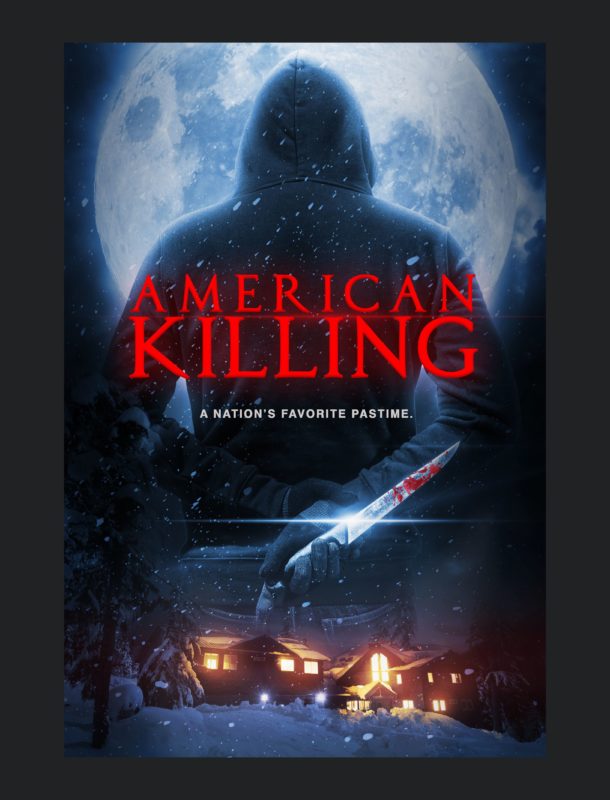American Killing (2016)
Directed by: Justyn Ah Chong, Matthew D. Ward
Written by: Matthew D. Ward
Starring: Caitlin Gerard, Melinda Lee, Persia White, Trevor Peterson

AMERICAN KILLING
Directed by Matthew D. Ward
You may have heard of this before when it attracted some attention during a very limited festival run under the name Wichita. It’s the debut film, and so far sole feature film, of directors Justyn Ah Chong and Matthew D. Ward (also the writer). Hopefully, the wider release means we’ll see some more of them, as it’s an entertaining if a very flawed, slice of dark comedy horror. And a reasonable neat twist on found footage.
American Killing, as it’s now known, is about the mental disintegration of a failing children’s TV maker. Jeb (Peterson) has worked extremely hard on making his show a success, but with diminishing ratings, he’s down to the last chance with his network. They want 30 episodes written in 30 days. Fortunately, he’s not alone, since he’ll be scripting them on a writer’s retreat with a team. Though unfortunately, his team are mostly lazy, self-focused and don’t like him very much. To be fair, they have every reason to find him a bit weird. Jeb wants to make his documentary so he’s set hidden cameras all over the place to get a glimpse in on their private lives as they flirt, drink and shag. He also manipulates them, with (among other things) goofy stories about one of the team being a killer. If this is him when he thinks he can rescue the show, just imagine him when he finds out it’s been cancelled.
At one point, a character opines that audiences find the baddie fascinating, as we want to know why they do it. Evidently, Ward agrees so it’s over to Trevor Peterson to carry much of the movie. Luckily he’s outstanding, playing Jeb as the offspring of Norman Bates and David Brent: unhinged and dangerous, but just insecure enough to be relatable. He handles his disintegration well, going between the parts of the protagonist and antagonist with skill. I’d go as far as saying the few scenes without him feel incomplete. Though this is also partially because the supporting cast has less to work with, and for the most part, are painted in broad strokes. This means they are largely defined by a single characteristic or trope.
To an extent, this shouldn’t matter too much, since we’re there to see everyone else die. So to an extent, they just need to be useless enough to make you feel for Jeb as he gets more and more tightly wound by their ineptitude. However, towards the end, the film switches perspectives, with the last section watching like a more traditional slasher from their side. It’s a relatively neat design, even if it’s been done a few times before. But with a killer, we already know intimately, and no budget for gory effects and big kills, the flat writing really hurts the film. There’s not much reason to want to see them live or particularly care if they don’t.
The main exception is Melinda Lee as Joan, whose motherly relationship with Jeb is the closest we have to an emotional core to the story. She can see the best in him, in a way that the audience hopefully will too. Speaking of mothers, by contrast, the sequence involving his biological one marks a low point for the movie and undermines the more thoughtful character study of the first half. We know from earlier that he has had a difficult life, including difficulties with drugs. Still, the ensuing bit of exaggerated violence, that feels dumped in solely to artificially boost the tension, is a contrived means of getting Jeb in the headspace for act three. It’s convenient but doesn’t quite hang together as a character journey. Which is necessary given the movie takes its time to get there.
This brings me to the pacing. At a scant 85 minutes, you’d think the issues with characterisation would be due to the forward momentum. And to an extent, this is the case. The situation and characters are all introduced within the first 7 minutes, so viewers hit the ground running and don’t get a satisfying introduction to the show itself nor the pressure on Jeb. Yet there’s also too much oscillation to it, with much of the following hour feeling stilted, where some scenes are drawn out and others rushed. Which means it struggles to really find its source of tension. When the killings start in the closing twenty-five minutes or so, it’s a welcome change, if too little too late. Still, I see the potential and, unlike the execs, would be more than happy to give Chong and Ward another chance.
Rating: 






Be the first to comment